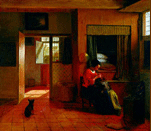










31.
Interior Designs: The Built Environment
and Early Modern Women’s Subjectivities
Organizers:
Description:
This workshop will examine a wide range of genres (e.g. epitaph,
emblem, conduct book, closet drama, portrait, conversion narrative, diary,
architectural plan), both fictional and non-fictional, and written or created
by men as well as by women. Our aim in privileging breadth over depth in terms
of the number of texts we read is to help us begin to get a sense of the complexity
of the ways women’s “multiple cultural and social frames”
“define, enable and constrain women’s subjectivity”; we
have chosen texts written by or about women of different classes and religious
beliefs, for example. The ways in which notions of the community and the individual
play out in the built environment can be examined, for example, in Lady Anne
Drury and Lady Anne Clifford’s concerns about their role in family dynasties
(as Elizabeth Chew argues, dynasty is one of the keys to both male and female
selfhood in the period) as compared to the Puritan emphasis on the individual
within (or without) a community of the elect which Sara Wight and Hannah Allen
articulate. These written and visual texts and physical structures, considered
individually or collectively, present a number of methodological and interpretative
challenges (working with the visual and the verbal; the avoidance of anachronism;
comparing the rhetoric of fictional and non-fictional texts; the use of psychoanalytic
theory) for the early modern scholar, and, compared and contrasted to one
another, serve to articulate in often surprising ways a number of questions
about early modern “structures and subjectivities.” Our focus
will be twofold: 1) on the ways in which literal, physical space (this can
also be the two-dimensional space of the page or painting) is used to define
the female self (and vice versa, so that there is often a reciprocal shaping
involved), or in some cases—as in Hannah Allen’s attempt to bury
herself under the floorboards of her cousin’s house—destroy the
self; 2) on the ways in which spatial metaphor is used to enable knowledge
or possession of the self.
It has long been recognized that early modern women’s identity was to
a large degree bound up with their ability or desire to control the borders
of their bodies, so that what was inside (the female tongue, for example)
remained inside, and what was outside (the male penis, for example) remained
outside, except under socially regulated circumstances. This cultural fear
of and desire to control the permeability of a woman’s bodily borders
was mirrored in the early modern woman’s relegation to the domestic
or private sphere; she needed to be doubly shut up, as it were. An additional
anxiety concerned the susceptibility of their soul and body to intrusions,
indeed possession by, the devil. However, the simple dichotomy between private
and public has, in the last several years, been shown to be inadequate in
understanding most especially, the ways in which space and place are gendered,
and the ways in which women related to space and place.
Our four main excerpted texts are the painted closet of emblems, owned (and,
Meakin argues, at least designed and possibly created) by Lady Anne Drury,
the friend and patroness of John Donne; Henry Jesse’s eye- and earwitness
account of Sarah Wight’s spiritual struggles and her oracular utterances
delivered from her bed (presented by Vera Camden); Lady Anne Clifford’s
description of her travels between her castles and her progression through
their interiors (presented by Elizabeth Chew); and Hannah Allen’s conversion
narrative (presented by Kimberly Hill) which, as Hill notes, “shows
us more about the structural shifts of Allen’s psychic spaces than her
spiritual development”. Some context for Lady Drury’s closet is
given by Brathwait’s The English Gentlewoman and by Bishop Rainbowe’s
description of Lady Anne Clifford’s improvised closet. Both these texts
provide different perspectives on women’s privacy and the tensions between
prescriptions and actual lived experience. Lady Anne Clifford’s portrait
in her closet in the famous Great Picture provides a counterpoint to the complete
absence of Lady Anne Drury’s body at the center of her closet and her
epitaph (which contains a blank space which should have listed her accomplishments,
although her body lies in the tomb on which the epitaph is carved). Both Clifford
and Drury, however, are, in their own ways, intensely concerned with the perpetuation
(or, in Drury’s case, the end) of family dynasties, a more temporally
inflected concern which both women clearly desire to manifest spatially and
structurally. The excerpt from Cavendish’s The Convent of Pleasure provides
a fictional imagining of women with the freedom to “incloister”
themselves not with the aim of a life of asceticism, but in order to enjoy
sensory and intellectual pleasures apart from the annoyances of men. Saint
Teresa’s notion of the soul (of men and women) as a castle in the innermost
center of which dwells God provides a useful counterpoint. The class inflection
of Lady Happy’s convent works in complicated ways with the gendering
of an all-female space, as does the discovery of men within its walls and
the resolution of the plot. Cavendish’s utopian imagining, and her extended
building metaphor in her verse prologue to her plays in its determination
to lay claim to the property of her texts, resonates with Clifford’s
actual struggle to access her castles and Drury’s own apparent sense
of her tiny room providing her with a sense of freedom rather than constraining
her. Wight escapes from her mother’s house and the containment of her
bedchamber to go rambling by the Thames River looking for self-destructive
opportunities, yet it is only when she is able to develop some self-restraint
and containment through her belief in Christ’s maternal “holding”
that she is no longer suicidal.
We will ask participants to submit via email before the conference one question
and one “answer”; that is, a sense of what they wish to know more
about, and something from their own work as it intersects with the reading
materials which they can offer the group. Organizers will provide 5 minutes
each of context (n.b. Meakin’s video clip can be cut to a minute or
at most 2 minutes!). We will then break into smaller groups for 20 minutes,
and afterwards come together again to discuss the material with all participants.
Preliminary List of Readings and Images:
Suggested Reading:
(precise selections TBA from 1 or 2 of these titles, most likely the first
two!)
|
|
|
||||||
|
|
 |
 |
|
||||
 |
|
 |
|
||||
|
|
|
||||||
|
|
|
||||||
 |
|
||||||
|
|
|
||||||
| |
|
||||||
 |
|
||||||
 |
|
||||||
 |
|
||||||
 |
|
||||||
|
|
|
||||||
|
|
 |
|
|
||||
 |
|
||||||
|
|
|
|
|
|
|
|
|